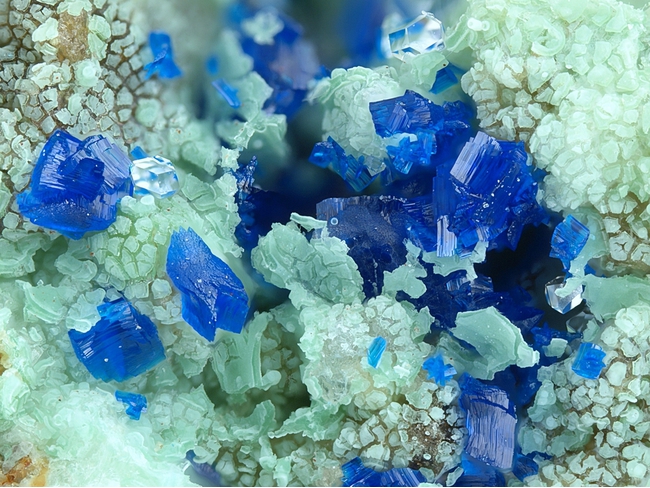Kinoite
A valid IMA mineral species
This page is currently not sponsored. Click here to sponsor this page.
About Kinoite
Formula:
Ca2Cu2(H2O)2[Si3O10]
Colour:
Deep blue
Lustre:
Vitreous
Hardness:
2½
Specific Gravity:
3.13 - 3.19
Crystal System:
Monoclinic
Name:
Named for the Italian Jesuit missionary Eusebio Francisco Kino (born August 10, 1645 in the village of Segno, Predaia, Val di Non, Trento, County of Tyrol, Holy Roman Empire (later Austrian Empire and Austro-Hungarian Empire, presently Italy - died March 15, 1711)).
In 1687 he established his first mission among the Indians of Sonora at Nuestra Senora de los Dolores. as well as new missions, including San Xavier del Bac (1700) near Tucson, Guevavi, and Tumacacori. In 1691, Father Kino made the first of about 40 expeditions into Arizona. He helped the Pima Indians in diversifying their agriculture and aided them in their continuous wars with the Apaches, while opposing Indian enslavement in the silver mines of northern Mexico.
Pronounced kē'-nō-ite.
In 1687 he established his first mission among the Indians of Sonora at Nuestra Senora de los Dolores. as well as new missions, including San Xavier del Bac (1700) near Tucson, Guevavi, and Tumacacori. In 1691, Father Kino made the first of about 40 expeditions into Arizona. He helped the Pima Indians in diversifying their agriculture and aided them in their continuous wars with the Apaches, while opposing Indian enslavement in the silver mines of northern Mexico.
Pronounced kē'-nō-ite.
According to the published type description (Anthony, John W., Laughton, Robert B. (1970) Kinoite, A new hydrous copper calcium silicate mineral from Arizona. The American Mineralogist, 55(5-6), 709-713.) the type locality is https://www.mindat.org/loc-424891.html , Unnamed drill core (kinoite type locality), Helvetia-Rosemont Mining District, Pima County, Arizona, USA
Unique Identifiers
Mindat ID:
2213
Long-form identifier:
mindat:1:1:2213:8
GUID
(UUID V4):
(UUID V4):
ff0a4334-7c1d-4bea-9f05-0a1057a2e998
IMA Classification of Kinoite
Approved
IMA Formula:
Ca2Cu2Si3O10 · 2H2O
Approval year:
1969
First published:
1970
Classification of Kinoite
9.BH.10
9 : SILICATES (Germanates)
B : Sorosilicates
H : Sorosilicates with Si3O10, Si4O11, etc. anions; cations in tetrahedral [4] and greater coordination
9 : SILICATES (Germanates)
B : Sorosilicates
H : Sorosilicates with Si3O10, Si4O11, etc. anions; cations in tetrahedral [4] and greater coordination
57.1.2.1
57 : SOROSILICATES Si3O10 Groups and Larger Noncyclic Groups
1 : Insular Si3O10 and Larger Noncyclic Groups with [Si3O10] groups
57 : SOROSILICATES Si3O10 Groups and Larger Noncyclic Groups
1 : Insular Si3O10 and Larger Noncyclic Groups with [Si3O10] groups
14.2.9
14 : Silicates not Containing Aluminum
2 : Silicates of Cu
14 : Silicates not Containing Aluminum
2 : Silicates of Cu
Mineral Symbols
As of 2021 there are now IMA–CNMNC approved mineral symbols (abbreviations) for each mineral species, useful for tables and diagrams.
| Symbol | Source | Reference |
|---|---|---|
| Kin | IMA–CNMNC | Warr, L.N. (2021). IMA–CNMNC approved mineral symbols. Mineralogical Magazine, 85(3), 291-320. doi:10.1180/mgm.2021.43 |
Physical Properties of Kinoite
Vitreous
Transparency:
Transparent
Colour:
Deep blue
Hardness:
2½ on Mohs scale
Cleavage:
Very Good
excellent {010}, distinct {001} and {100}
excellent {010}, distinct {001} and {100}
Density:
3.13 - 3.19 g/cm3 (Measured) 3.193 g/cm3 (Calculated)
Optical Data of Kinoite
Type:
Biaxial (-)
RI values:
nα = 1.638 nβ = 1.665 nγ = 1.676
2V:
Measured: 68° , Calculated: 64°
Max Birefringence:
δ = 0.038

Image shows birefringence interference colour range (at 30µm thickness)
and does not take into account mineral colouration.
and does not take into account mineral colouration.
Surface Relief:
Moderate
Dispersion:
Relatively weak. Type description gives r < v, distinct.
Optical Extinction:
X = b, Z ∧ c ≃ 0°.
Pleochroism:
Strong
Comments:
X= pale greenish blue
Y= blue
Z= deep blue
Y= blue
Z= deep blue
Comments:
Absorption: Z > Y > X.
Chemistry of Kinoite
Mindat Formula:
Ca2Cu2(H2O)2[Si3O10]
Common Impurities:
Mg
Crystallography of Kinoite
Crystal System:
Monoclinic
Class (H-M):
2/m - Prismatic
Space Group:
P21/m
Cell Parameters:
a = 6.99 Å, b = 12.88 Å, c = 5.65 Å
β = 96.18°
β = 96.18°
Ratio:
a:b:c = 0.543 : 1 : 0.439
Unit Cell V:
505.72 ų (Calculated from Unit Cell)
Z:
2
Morphology:
Tabular in the plane of b and c axes. [hk0] zone is striated. Pseudoorthorhombic.
Crystal Structure
Load
Unit Cell | Unit Cell Packed
2x2x2 | 3x3x3 | 4x4x4
Unit Cell | Unit Cell Packed
2x2x2 | 3x3x3 | 4x4x4
Show
Big Balls | Small Balls | Just Balls | Spacefill
Polyhedra Off | Si Polyhedra | All Polyhedra
Remove metal-metal sticks
Big Balls | Small Balls | Just Balls | Spacefill
Polyhedra Off | Si Polyhedra | All Polyhedra
Remove metal-metal sticks
Display Options
Black Background | White Background
Perspective On | Perspective Off
2D | Stereo | Red-Blue | Red-Cyan
Black Background | White Background
Perspective On | Perspective Off
2D | Stereo | Red-Blue | Red-Cyan
View
CIF File Best | x | y | z | a | b | c
CIF File Best | x | y | z | a | b | c
Rotation
Stop | Start
Stop | Start
Labels
Console Off | On | Grey | Yellow
Console Off | On | Grey | Yellow
Data courtesy of the American Mineralogist Crystal Structure Database. Click on an AMCSD ID to view structure
| ID | Species | Reference | Link | Year | Locality | Pressure (GPa) | Temp (K) |
|---|---|---|---|---|---|---|---|
| 0000222 | Kinoite | Laughon R B (1971) The crystal structure of kinoite American Mineralogist 56 193-200 |  | 1971 | 0 | 293 |
CIF Raw Data - click here to close
X-Ray Powder Diffraction
Image Loading
Radiation - Copper Kα
Data courtesy of RRUFF project at University of Arizona, used with permission.
Powder Diffraction Data:
| d-spacing | Intensity |
|---|---|
| 4.72 Å | (100) |
| 3.052 Å | (81) |
| 6.44 Å | (74) |
| 2.116 Å | (41) |
| 3.138 Å | (30) |
| 2.315 Å | (30) |
| 3.951 Å | (26) |
Geological Environment
Paragenetic Mode(s):
| Paragenetic Mode | Earliest Age (Ga) |
|---|---|
| High-𝑇 alteration and/or metamorphism | |
| 31 : Thermally altered carbonate, phosphate, and iron formations |
Type Occurrence of Kinoite
General Appearance of Type Material:
Veinlets and crystals embedded in apophyllite. Euhedral crystals to 1mm. From drill core.
Place of Conservation of Type Material:
Harvard University, Cambridge, Massachusetts, USA, 109439.
National Museum of Natural History, Washington, D.C., USA, 122395.
Department of Geology, University of Arizona, Arizona, USA.
National Museum of Natural History, Washington, D.C., USA, 122395.
Department of Geology, University of Arizona, Arizona, USA.
Geological Setting of Type Material:
Skarn and fault gouge.
Associated Minerals at Type Locality:
Reference:
Anthony, J.W., Laughton, R.B. (1970) Kinoite, A new hydrous copper calcium silicate mineral from Arizona. American Mineralogist: 55: 709-713.
Synonyms of Kinoite
Other Language Names for Kinoite
Common Associates
Associated Minerals Based on Photo Data:
| 98 photos of Kinoite associated with Fluorapophyllite-(K) | KCa4(Si8O20)(F,OH) · 8H2O |
| 91 photos of Kinoite associated with Apophyllite Group | AB4[Si8O22]X · 8H2O |
| 76 photos of Kinoite associated with Hydroxyapophyllite-(K) | KCa4(Si8O20)(OH,F) · 8H2O |
| 56 photos of Kinoite associated with Gilalite | Cu5Si6O17 · 7H2O |
| 18 photos of Kinoite associated with Ruizite | Ca2Mn3+2[Si4O11(OH)2](OH)2 · 2H2O |
| 16 photos of Kinoite associated with Quartz | SiO2 |
| 15 photos of Kinoite associated with Calcite | CaCO3 |
| 13 photos of Kinoite associated with Silver | Ag |
| 7 photos of Kinoite associated with Junitoite | CaZn2Si2O7 · H2O |
| 7 photos of Kinoite associated with Stringhamite | CaCu(SiO4) · H2O |
Related Minerals - Strunz-mindat Grouping
| 9.BH. | Bunnoite | Mn2+6AlSi6O18(OH)3 |
| 9.BH.05 | Aminoffite | Ca2(Be,Al)(Si2O7)(H2O,OH) |
| 9.BH.15 | Akatoreite | Mn2+9Al2Si8O24(OH)8 |
| 9.BH.20 | Fencooperite | Ba6Fe3+3Si8O23(CO3)2Cl3 · H2O |
Other Information
Notes:
Decomposed in dilute HCl, without effervescence, with the development of a white residue.
Health Risks:
No information on health risks for this material has been entered into the database. You should always treat mineral specimens with care.
Internet Links for Kinoite
mindat.org URL:
https://www.mindat.org/min-2213.html
Please feel free to link to this page.
Please feel free to link to this page.
Search Engines:
External Links:
Mineral Dealers:
References for Kinoite
Reference List:
Anthony, John W., Laughon, Robert B. (1970) Kinoite, a new hydrous copper calcium silicate mineral from Arizona. American Mineralogist, 55 (5-6) 709-715
Kusachi, Isao, Nishimura, Makoto, Shiraga, Kanako, Kobayashi, Shoichi, Yamakawa, Junji (2001) Kinoite from Fuka, Okayama Prefecture, Japan. Journal of Mineralogical and Petrological Sciences, 96 (1) 29-33 doi:10.2465/jmps.96.29
Frost, Ray L., Xi, Yunfei (2012) Vibrational spectroscopic study of the copper silicate mineral kinoite Ca2Cu2Si3O10(OH)4. Spectrochimica Acta Part A: Molecular and Biomolecular Spectroscopy, 89. 88-92 doi:10.1016/j.saa.2011.12.051
Localities for Kinoite
Locality List
 - This locality has map coordinates listed.
- This locality has map coordinates listed.
 - This locality has estimated coordinates.
ⓘ - Click for references and further information on this occurrence.
? - Indicates mineral may be doubtful at this locality.
- This locality has estimated coordinates.
ⓘ - Click for references and further information on this occurrence.
? - Indicates mineral may be doubtful at this locality.
 - Good crystals or important locality for species.
- Good crystals or important locality for species.
 - World class for species or very significant.
(TL) - Type Locality for a valid mineral species.
(FRL) - First Recorded Locality for everything else (eg varieties).
- World class for species or very significant.
(TL) - Type Locality for a valid mineral species.
(FRL) - First Recorded Locality for everything else (eg varieties).
All localities listed without proper references should be considered as questionable.
Quick NavTopAbout KinoiteUnique IdentifiersIMA Classification Classification Mineral SymbolsPhysical Properties Optical Data Chemistry Crystallography Crystal StructureX-Ray Powder DiffractionGeological EnvironmentType Occurrence SynonymsOther LanguagesCommon AssociatesStrunz-MindatOther InformationInternet Links References Localities Locality List






 symbol to view information about a locality.
The
symbol to view information about a locality.
The 




Christmas Mine, Christmas, Banner Mining District, Gila County, Arizona, USA